Boesemani Rainbowfish, a species of freshwater fish, enjoys a lot of popularity in the aquarium industry. This is due to their vibrant rainbow-colored hues, as their name suggests. As with most colorful fish, these act as a centerpiece to any aquarium. They are not only easy to care for, but also beautiful-looking. This makes them perfect for aquarists who are starting!
Boesemani Rainbowfish is also known as ‘Bicolour Rainbow Fish’ or ‘Boeseman’s Rainbowfish’. Apart from their beautiful colors, they also have quite rare and interesting designs. This makes them a center of attraction in any tank.
| Information Chart | |
| Scientific Name: | Melanotaenia boesemani |
| Family: | Melanotaeniidae |
| Care Level: | Easy |
| Temperament: | Peaceful |
| Colour: | Blue heads with red rears |
| Lifespan: | 5 to 8 years |
| Size: | Up to 4.5 inches |
| Diet: | Omnivorous |
| Minimum Tank Size: | 30 gallons |
| Temperature: | 70°F to 79°F |
| Water Conditions: | pH 7.0 to 8.0 |
| Tank Mate Compatibility | Peaceful community |
Table of Contents
Boesemani Rainbowfish Appearance
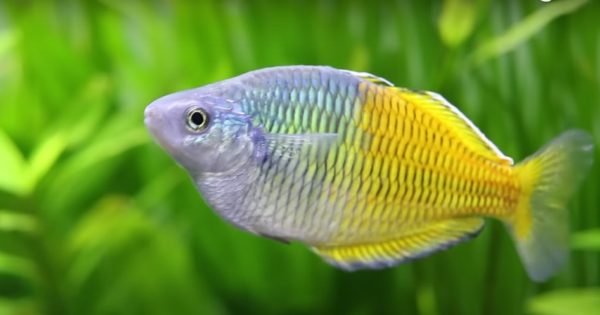
As the name suggests, there is a reason they’re called rainbowfish. They are a species having two halves in their coloration. Most Boesemani Rainbowfish have warmer tones making up the rear such as reds, oranges, and yellows. The front has cooler tones such as blues, purples, greens.
Most Boesemani Rainbowfish have a vibrant band of bluish-grey scales with a hint of purple along the front part of the body. There is a colored orange-red on the rear, with a smidge of yellow. These two hues blend in the middle, resulting in some green or black thin stripes. Males are often more colored than their female counterparts. Females have the same hues, albeit a little faded with an intense silver. We can see this in the fins, which, in the case of females, appear almost opaque or yellow.
The shape of their body is a flat oval and their tailfin pokes out at the rear. The rest of their fins are not quite as predominant and don’t protrude out of their body. The narrow shape of their head points to the front. The Boesemani Rainbowfish has larger eyes and smaller mouths.
These colors vary according to different factors. These can be the health of the fish, and even the moods, or when they are ready to mate. The colors are a little dull when the fish are sick. They are more intense when they are healthy. They appear brighter during the nighttime.
When a Boesemani Rainbowfish is around 2.5 inches in length, that is when most of these vibrant hues start to show.
The lifespan of Boesemani Rainbowfish
The typical lifespan of a Boesemani Rainbowfish is 5 to 8 years. Boesemani Rainbowfish can live for a very long time in captivity, with some even reaching up to 12 years of age!
Boesemani Rainbowfish Size
The typical male Boesemani Rainbowfish grows up to 4.5 inches long. The female Boesemani Rainbowfish may grow up to 3 inches, but not more than that.
Natural Habitat and Origin
Allen and Cross described the Boesemani Rainbowfish in 1980. The Boesemani Rainbowfish is native to the tropical climate of the Ayamaru, Hain, and Aytinjo Lakes in Indonesia. More specifically, they are in the Vogelkop Peninsula of Western New Guinea. This is the only place where you can find the natural population of Boesemani Rainbowfish. The Boesemani Rainbowfish is an endangered species. Hence, it needs special consideration. Over-harvesting has wiped away most of the population. This has disturbed the balance of the ecosystem they live in.
The majority of them found in aquariums are bred in captivity with other species. Hence, you can find them easily and they are cheaper to buy.
In the wild, they tend to live in swamps and shallow tributaries covered with dense vegetation.
Boesemani Rainbowfish Care and Tank Set-up
Tank Size and Specifications
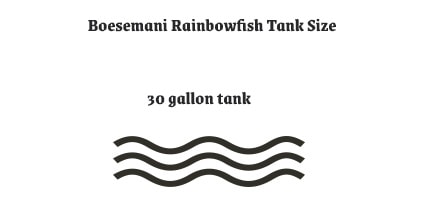
Optimum Tank Size for Boesemani Rainbowfish
The recommended tank size for Boesemani Rainbowfish is 30 gallons. It is quite a durable and hardy species and a school of 6 can live and thrive in a tank that is about 30 gallons. The Boesemani Rainbowfish is also an active jumper, so the tank needs to be at least 30 inches long. If the tank is smaller than this, it can lead to stress in the fish due to the lack of room. As the Boesemani Rainbowfish is an active species, it needs plenty of room to swim around in. With every extra fish that you add to the tank, the tank size should increase by an extra 5 gallons.
Tank Shape for Boesemani Rainbowfish
Bigger tanks are suitable for Boesemani Rainbowfish. Any tank that is the size of 30 or more gallons should be fine. They are also suitable for a nano tank.
Filter Type
Boesemani Rainbowfish does not have any strict requirements for filter types. Yet, you need an efficient filter with good water movement. This is especially important for male fishes to develop their colors better.
Substrate
The Boesemani Rainbowfish belongs to swampy, vegetative waters. So, an aquarist needs to replicate that environment. To make the Boesemani Rainbowfish feel at home you should use a sandy, gravel mixed substrate.
How Many Boesemani Rainbowfish in a 30 Gallon Tank?
Five to six Boesemani Rainbowfish can live comfortably in a 30-gallon tank. But, it is a large fish and an active swimmer as well, so a larger tank size is always preferred. Overcrowding will lead to stress among the school. This is something that you must consider when increasing the school size.
Water Parameters
Water Temperatures
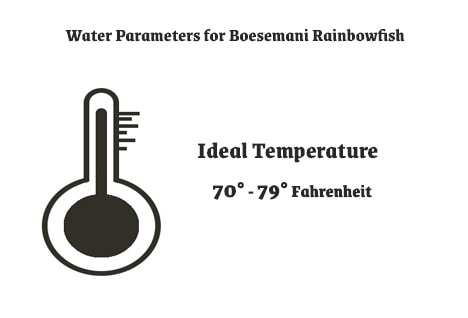
The ideal temperature for Boesemani Rainbowfish is between 70 to 79 degrees F. 72 degrees is the ideal temperature for breeding. The Boesemani Rainbowfish is a tropical fish, so the temperature should not go below the above-mentioned degree. Otherwise, it will cause discomfort to the fish. If the tank is in a cold room, use a heater to warm the water. The water changes should be weekly, depending on the density of the fish. At least 25-50% of the tank water should be replaced mandatorily.
Water Flow Rate
Even though the Boesemani Rainbowfish are easy to care for, they will fall sick if the water quality is poor. This can also happen if the water movement is too slow or too fast. They prefer a moderate water movement, which is best for them to thrive. They will tend to gather in the middle of the water, in an open space in the aquarium.
pH Level
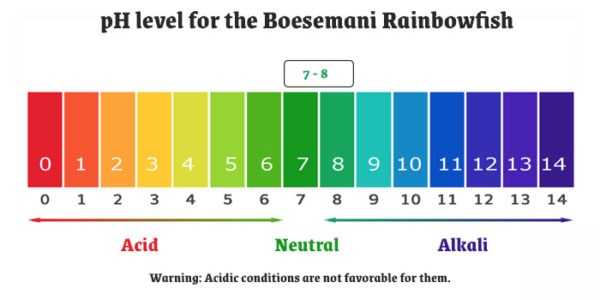
The perfect pH level for Boesemani Rainbowfish should be between 7.0 to 8.0. Their natural environment is warm, so the pH level mustn’t fluctuate. They are quite sensitive to these fluctuations. They will not do well in soft, acidic conditions.
Water Hardness
The appropriate water hardness for Boesemani Rainbowfish is 10 to 20 dGH. The Boesemani Rainbowfish is a species that cannot tolerate brackish water at all. Getting the water hardness correct becomes vital here.
Tank Landscape
Best Plants for Boesemani Rainbowfish Tanks
While choosing plants for a Boesemani Rainbowfish tank, it is important to choose plants that can withstand the alkaline, hard water that these fish are used to. They will also need vast, open stretches of water to swim and move around in, so the placement of the plants is also crucial. An aquarist should pick small-leafed plants such as Java Moss, Java Fern, and Star Grass. These plants need to be arranged around the perimeter of the tank to leave open space in the middle.
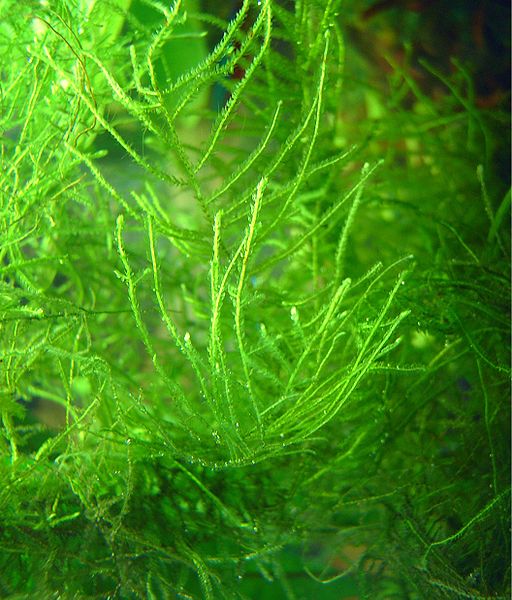
Worst Plants for Boesemani Rainbowfish Tanks
Any plants that do not have small leaves, or spawning, or spindly mops will not do for a Boesemani Rainbowfish tank. They leave no space for the movement of the fish.
Decorations for Boesemani Rainbowfish Tanks
Mixing these plants with other items for decor such as driftwood, leaf litter or pieces of rock is a great addition to any tank. Adding items like a small plant or a colorful rock keep the fish engaged, as they love playing hide and seek around these massive structures.
Lighting for Boesemani Rainbowfish Tanks
Boesemani Rainbowfish need moderate to normal lighting to thrive. As Boesemani Rainbowfish is a tropical fish, an aquarist can try, if possible, to plan sunlight that hits the tank for an hour or two every day. Not only will this be helpful to the fish, but it will also give the viewer to witness their brilliant colors in all their glory!
Feeding Boesemani Rainbowfish
Best Diet for Boesemani Rainbowfish
Boesemani Rainbowfish are omnivores. They eat small crustaceans, insects, and even some vegetation, etc.
We should give them high-quality flake food. They need a good amount of nutrition. This is also important to develop their coloration. A mix of live and processed foods would be advisable. Boesemani Rainbowfish enjoy eating live food like bloodworms, tubifex worms, water fleas, brine shrimp, etc.
We can also give them dry food like pellets and flakes. These are quite convenient and provide the necessary nutrients. Boesemani Rainbowfish can also eat green vegetables, so one could provide them with small pieces of zucchini or spinach as well.
How Often Should You Feed Boesemani Rainbowfish?
Boesemani Rainbowfish needs us to feed them many times during the day. An aquarist must keep in mind to only give them food which they can consume in 5 minutes or less at each feeding. Otherwise, you might overfeed them.
Boesemani Rainbowfish Behaviour and Temperament
Are Boesemani Rainbowfish societal or lone in nature?
Boesemani Rainbowfish is usually a peaceful fish. They are quite sociable and will thrive in a larger fish community tank. However, they will do exceptionally well if they are placed with other rainbowfish! They are not aggressive, but if they encounter overly aggressive tank mates or shy tank mates, they will tend to bully them. For a peaceful tank environment, it is advised to place them with other playful fish. There is often chasing around in a rainbowfish tank, but this is not a concern unless some fish is injured. They are majorly schooling fish, and so the male to female ratio is quite important. Even factors such as coloration, etc. depend on the balance between the two sexes in the tank.
Boesemani Rainbowfish Tank Mates
Ideal Boesemani Rainbowfish Tank Mates
Boesemani Rainbowfish will prefer living with other rainbowfish the best! Some invertebrates can also be chosen to be their tank partners. They are also quite active and will get along well with other tank mates such as:
- Angelfish
- Danios ( Celestial Pearl )
- Tiger Barbs
- Corydoras Catfish
- Neon Tetra
- Discus
- Other Rainbowfish
Bad Tank Mates for Boesemani Rainbowfish
Boesemani Rainbowfish might scare or startle slow-moving tankmates, as well as some skittish fish, such as:
Breeding Boesemani Rainbowfish
Breeding Boesemani Rainbowfish is quite an easy process. It needs to follow certain optimal conditions and is a careful process. These optimal conditions are a separate breeding tank, hard and acidic water with a pH of 7.5. You will need a temperature of 72 degrees F and a regular feeding process with live food. You will also need short plants with similar characteristics.
Before the process can begin, a breeding tank needs to be set up with a sponge filter. Or there should be plants with a spawning mop for cover. The next step is to introduce one or two females into the tank, conditioned with live foods and plant foods. To get better results, feed them higher quality food than the one used.
After several hours, introduce two or three male fish to the breeding tank.
The spawning period lasts for about two weeks. During this time, the females will lay several eggs among the tank plants, which in turn will stick to the leaves.
After the female has produced eggs, the males tend to showcase a display of colors. They direct the females to the spawning site, and spawn and take rest. Post this, the spawning plants must be removed and replaced, or else the eggs run a risk of being eaten. If not by their parents, by other tank mates — as the Boesemani Rainbowfish do not show any signs of parental instincts. They will try to eat their eggs immediately after they’re scattered. It is here that an aquarist must act quickly to separate them from the eggs. The adult fish will exhibit this same behavior for a few days, daily. There will be a decreasing amount of eggs produced.
To safeguard the eggs, one must put them into another tank that has the same water parameters. Here the eggs can develop and hatch. This entire process takes about seven to twelve days.
Once the fry hatch, they need to be fed infusoria or liquid food until they can eat small live foods themselves. The process of the fry growing up can be a little tiresome as they grow slowly. They need clean water conditions throughout the time till they are at least two months old. Something to keep in mind is, not to use sinking foods to feed the fry. They will likely stay near the surface of the water.
Something to beware of is crossbreeding. It can result in rainbowfish losing their coloration or produce other undesirable results.
Boesemani Rainbowfish Breeding Level – Easy.
Boesemani Rainbowfish Sexual Dimorphism?
To distinguish between male and female Boesemani Rainbowfish, we must notice the difference in their hues and their size. As mentioned earlier, a grown male Boesemani Rainbowfish can be up to 4.5 inches long. The female Boesemani Rainbowfish does not grow more than 3 inches. The males also have a deeper, larger body than females. One can make out the sex of the fish by observing their colors and the above-mentioned differences.
Boesemani Rainbowfish Common Diseases and their Treatment
Boesemani Rainbowfish is quite a hardy species, but they are still prone to diseases. These might arise due to unhygienic living conditions such as unclean water.
Columnaris
If the water conditions are not ideal then the Boesemani Rainbowfish may develop Columnaris. These are long, thin hair-like structures hanging off the mouth of fish. This will go away as soon as the water conditions are good.
You can avoid most diseases through care and hygiene. But it is important to remember that adding any alien object, new fish species, anything that you add to the tank will bring disease. Items like decor, plants, etc. can also harbor bacteria. Since they are quite resilient, you can limit any outbreak to a couple of fish if treated in time.
Facts About Boesemani Rainbowfish
- You can find Boesemani Rainbowfish in swampy areas and the tributaries of Lakes Ayamaru, Hain, and Aitinjo.
- They have many names such as ‘Bicolour Rainbow Fish’ or ‘Boeseman’s Rainbowfish’.
- Boesemani Rainbowfish is an endangered species.
- The Boesemani Rainbowfish has larger eyes and smaller mouths.
- These colors vary according to different factors. Factors can be the health of the fish, and even the moods, or when they are ready to mate.
- A grown male Boesemani Rainbowfish can be up to 4.5 inches long. The female Boesemani Rainbowfish does not grow more than 3 inches.
Are Boesemani Rainbowfish Right for You?
Author’s note: Boesemani Rainbowfish are right for everyone as they are peaceful. They make for quite active fish-watching with their vibrant hues. It is fun to see them exploring their tank, and jumping about. They are the best addition to any home setting or aquarium environment. Their animated nature and their hardiness are unique.
FAQs
Boesemani Rainbowfish are quite hardy. If the tank is well-maintained they generally do not suffer from diseases. This makes them quite beginner-friendly.
One can keep up to 5 to 7 Boesemani Rainbowfish together in a small tank of 30 gallons.
Changing hues is a common thing among Boesemani Rainbowfish. The changing colors could be a signal that the fish are not healthy, or stressed, or are being chased by a tankmate. A long-term change in color could mean that the water parameters are wrong. You must check it using a water-testing kit.
Yes, they do school with species of other rainbowfish best!
Boesemani Rainbowfish can live with larger tetras. But this can only happen when they are equal in numbers to prevent aggression. One must only keep them both in schools or not at all.
As mentioned earlier, you can keep Boesemani Rainbowfish in a group of 5-7, even in a tank as small as 30-gallons.
Yes, Boesemani Rainbowfish are omnivores. They do eat algae, even planktons, and small insect larvae, crustaceans, etc.
No, that is not recommended. Boesemani Rainbowfish are very peaceful and the bettas are aggressive.
Yes, Boesemani Rainbowfish are quite easy to breed. But, you need to meet certain tank requirements. Please refer to the section above to understand it in more detail.
Conclusion
Boesemani Rainbowfish are very hardy, colorful, and beginner-friendly. This makes them the perfect choice for aquarists who are starting out. They will even keep experienced aquarists busy with the sheer joy of watching them flit about in their tank. It is also quite easy to set up an aquarium for them, given how simple their natural habitat is to recreate. Caring for them is an enriching experience for any and everyone.
No related posts.
